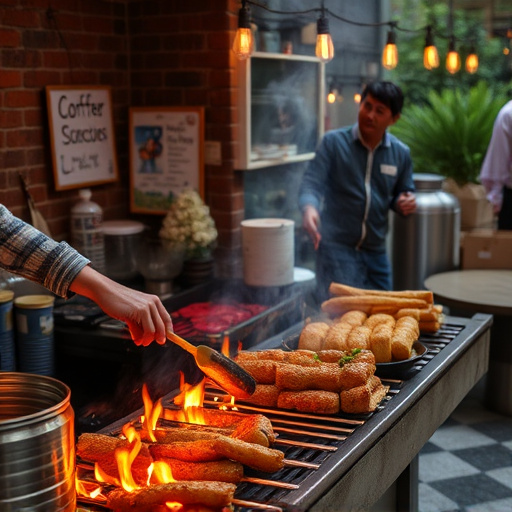Crafting a signature smoky flavor in pork BBQ involves slow-roasting over wood fire with specific woods like oak, hickory or mesquite. Choosing baby back or spare ribs and mastering the Dry Rub Technique ensures tender, flavorful results. Temperature control between 225°F – 250°F (107°C – 121°C) is crucial for deep smoke infusion without overcooking. Apple Cider Vinegar tenderizes meat and adds tanginess. Glazes and sauces elevate flavor, with suggestions like paprika-brown sugar or ketchup-vinegar-chili. Serve with fresh herbs, coleslaw, cornbread and cold beverages for a memorable pork BBQ experience.
“Unleash the mouth-watering combination of smoky barbecue flavor and juicy, tender pork ribs! This ultimate guide takes you on a culinary journey to perfection. Discover the art of crafting the perfect ribs, from choosing the ideal cut to mastering the science behind dry rubs and smoking techniques. Learn secrets like using apple cider vinegar for tenderness and explore diverse sauces for added depth. With our step-by-step approach, achieve rib-making mastery and impress with a mouthwatering pork BBQ recipe.”
- Understanding Smoky Barbecue Flavor Profile
- Selecting the Right Cut for Juicy Ribs
- Dry Rub Technique: Unlocking Flavor Potential
- Smoking Ribs: Mastering Temperature Control
- Apple Cider Vinegar: Secret to Tender Meat
- Sauces and Glazes: Adding Depth of Taste
- Presentation and Serving Suggestions
Understanding Smoky Barbecue Flavor Profile
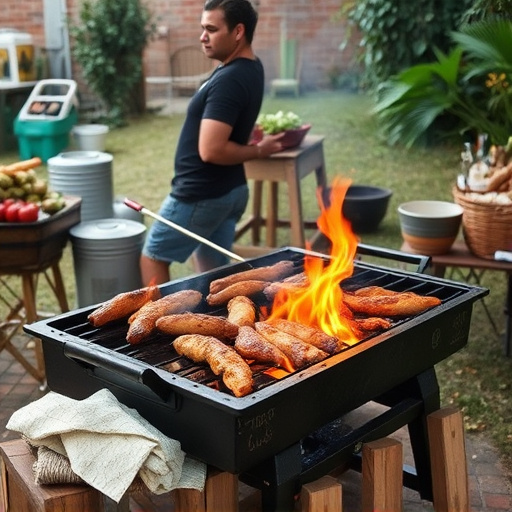
The smoky barbecue flavor profile is a harmonious blend of charred notes and rich, savory tones, created by slow-roasting meat over wood fire or chips. This distinct taste is deeply rooted in traditional barbecue culture, especially when it comes to crafting the perfect pork bbq recipe. The process involves carefully controlling the heat and utilizing specific woods, such as oak, hickory, or mesquite, each imparting unique flavors that enhance the overall profile.
This smoky essence infuses into the pork ribs during a slow-cooking process, resulting in tender, juicy meat with a complex flavor palette. The charred edges and succulent interior create a delightful contrast, making it a favorite among barbecue enthusiasts. Mastering this flavor profile requires patience and precision, but the reward is a mouthwatering dish that truly showcases the art of smoking meats.
Selecting the Right Cut for Juicy Ribs
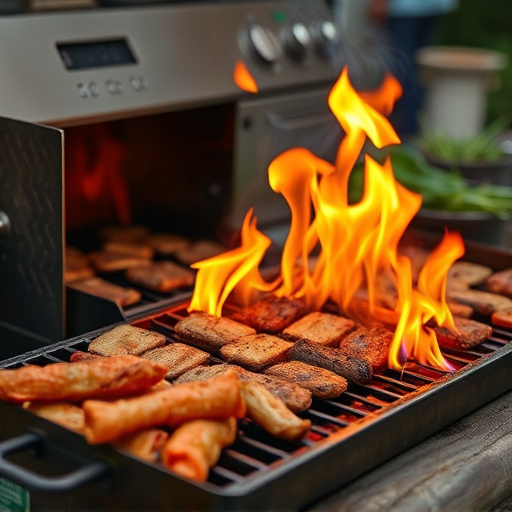
When it comes to achieving juicy, fall-off-the-bone pork ribs for your next barbecue, selecting the right cut is essential. Look for rib cuts that include both meaty ribs and surrounding muscle tissue, such as baby back or spare ribs. These cuts are well-marbled with fat, which not only adds flavor but also helps keep the ribs tender during slow cooking.
A good pork BBQ recipe starts with this fundamental choice. The right cut ensures that your ribs cook evenly, locking in juices and developing that coveted smoky barbecue flavor. Remember, the key is to find a balance between meat and fat for the best results in your mouthwatering pork bbq recipe.
Dry Rub Technique: Unlocking Flavor Potential
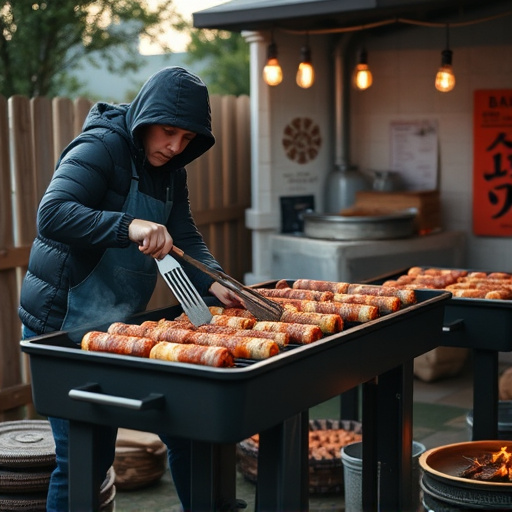
The Dry Rub Technique is a time-honored method that forms the foundation for unlocking the full potential of smoky, juicy pork ribs in any BBQ enthusiast’s repertoire. This simple yet effective approach involves coating the ribs with a blend of spices, known as a dry rub, before cooking them low and slow over indirect heat. The result? A mouthwatering combination of tender meat and robust, complex flavors that dance on your palate.
By carefully selecting and combining ingredients like paprika, garlic powder, salt, pepper, chili powder, and brown sugar, the dry rub creates a tantalizing crust that seals in juices during the cooking process. This technique not only enhances the overall taste but also contributes to the ribs’ tender texture, ensuring every bite is a delightful sensory experience. For those seeking an authentic pork BBQ recipe, mastering the dry rub technique is a must.
Smoking Ribs: Mastering Temperature Control
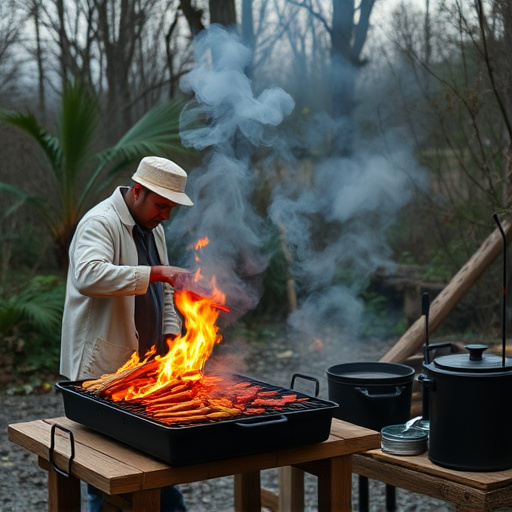
Mastering temperature control is key when smoking ribs, ensuring a perfect blend of smoky flavor and juicy meat. For optimal results in your pork BBQ recipe, maintain a consistent temperature range between 225°F to 250°F (107°C to 121°C). This slow cooking process allows the smoke to penetrate the meat, infusing it with a rich, complex flavor without overcooking or drying out the ribs.
Regularly monitor your smoker’s temperature using a reliable thermometer and adjust as needed. Adding wood chunks or logs according to the recipe will help maintain these ideal conditions, creating a delicious pork BBQ experience where every bite is a perfect balance of smoky, tender, and juicy rib goodness.
Apple Cider Vinegar: Secret to Tender Meat
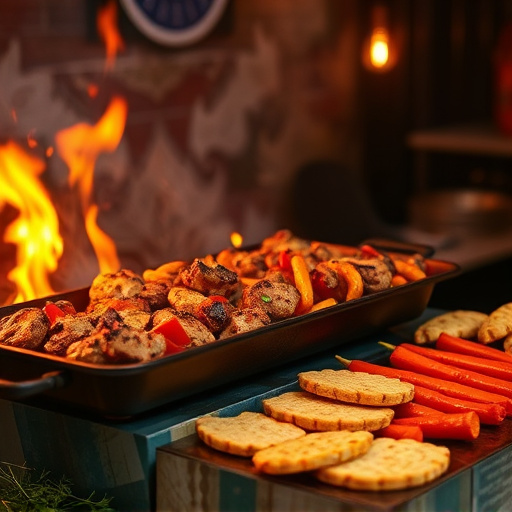
Apple Cider Vinegar (ACV) is a secret weapon in achieving tender, juicy pork ribs in your smoky barbecue recipes. This natural ingredient goes beyond just adding flavor; it acts as a meat tenderizer, breaking down collagen and connective tissues present in the rib meat. By marinating your pork ribs in a mixture of ACV and other aromatic spices before cooking, you can transform tough cuts into melt-in-your-mouth delights.
The acetic acid present in ACV helps to break down these tissues, making the meat more tender and easier to chew. Moreover, it adds a subtle tanginess that complements the smoky barbecue flavor, creating a harmonious blend of tastes that will have folks licking their bones clean. Incorporating ACV into your pork BBQ recipe is an easy way to elevate the overall dining experience.
Sauces and Glazes: Adding Depth of Taste
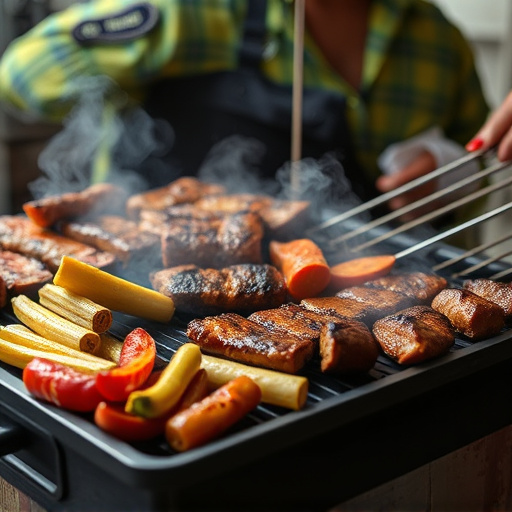
The beauty of pork ribs lies in their ability to absorb and showcase various flavors, making them a canvas for culinary creativity. When it comes to enhancing the taste of juicy pork ribs, sauces and glazes play a pivotal role. These condiments add a layer of depth that complements the smoky barbecue flavor, transforming an ordinary dish into a remarkable culinary experience.
For a mouthwatering pork BBQ recipe, consider a glaze infused with spices like paprika, brown sugar, and garlic. The sweet and savory combination clings to the ribs, intensifying the smoky taste from the grill. Alternatively, a simple sauce made with ketchup, vinegar, and a hint of chili powder can add a tangy kick while still letting the natural juices of the pork shine through. Experimenting with different sauces allows you to customize the flavor profile to suit your palate.
Presentation and Serving Suggestions
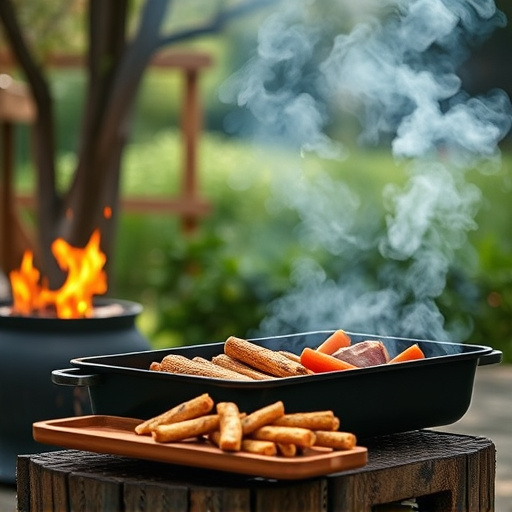
When it comes to presentation, a simple yet effective touch is to arrange the ribs on a large platter or board, garnished with fresh herbs and a drizzle of barbecue sauce. This visual appeal not only tempts the taste buds but also showcases the tender, juicy meat. For an immersive experience, serve these mouthwatering pork BBQ recipes alongside classic side dishes like coleslaw and cornbread, allowing diners to customize their plate with a generous helping of each.
Encourage your readers to embrace the full sensory experience by suggesting they pair their meal with ice-cold beverages, whether it’s a cold beer or a refreshing cocktail. The contrast of the smoky, savory ribs and the chill of the drinks will elevate the overall dining pleasure.
